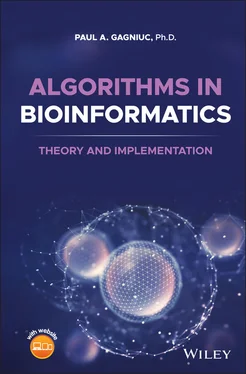Paul A. Gagniuc - Algorithms in Bioinformatics
Здесь есть возможность читать онлайн «Paul A. Gagniuc - Algorithms in Bioinformatics» — ознакомительный отрывок электронной книги совершенно бесплатно, а после прочтения отрывка купить полную версию. В некоторых случаях можно слушать аудио, скачать через торрент в формате fb2 и присутствует краткое содержание. Жанр: unrecognised, на английском языке. Описание произведения, (предисловие) а так же отзывы посетителей доступны на портале библиотеки ЛибКат.
- Название:Algorithms in Bioinformatics
- Автор:
- Жанр:
- Год:неизвестен
- ISBN:нет данных
- Рейтинг книги:3 / 5. Голосов: 1
-
Избранное:Добавить в избранное
- Отзывы:
-
Ваша оценка:
- 60
- 1
- 2
- 3
- 4
- 5
Algorithms in Bioinformatics: краткое содержание, описание и аннотация
Предлагаем к чтению аннотацию, описание, краткое содержание или предисловие (зависит от того, что написал сам автор книги «Algorithms in Bioinformatics»). Если вы не нашли необходимую информацию о книге — напишите в комментариях, мы постараемся отыскать её.
Explore a comprehensive and insightful treatment of the practical application of bioinformatic algorithms in a variety of fields Algorithms in Bioinformatics: Theory and Implementation
global
local sequence alignment, forced alignment
Sequence logos, Markov chains
Self-Sequence alignment, Objective Digital Stains
Spectral Forecast
Discrete Probability Detector
Self-sequence
Objective Digital Stains
Spectral Forecast
Algorithms in Bioinformatics: Theory and Implementation
Algorithms in Bioinformatics — читать онлайн ознакомительный отрывок
Ниже представлен текст книги, разбитый по страницам. Система сохранения места последней прочитанной страницы, позволяет с удобством читать онлайн бесплатно книгу «Algorithms in Bioinformatics», без необходимости каждый раз заново искать на чём Вы остановились. Поставьте закладку, и сможете в любой момент перейти на страницу, на которой закончили чтение.
Интервал:
Закладка:
About the Companion Website
This book is accompanied by a companion website:
www.wiley.com/go/gagniuc/algorithmsinbioinformatics
The website includes the following:
Algorithms in JavaScript
Charts for visualization
PowerPoint presentations
Sequence alignment (Jupiter bioinformatics application)
HTML/JavaScript files
1 The Tree of Life (I)
1.1 Introduction
This chapter provides an overview of life and draws near some important questions: When did life on earth begin? What is life? How is it organized? When did multicellular organisms appear and why? How many species exist on Earth? Notions of biology related to the emergence and classification of life are discussed in connection with different strategies on organism formation. Some ultrastructural images (electron microscopy) are presented as examples for reference. The lower and upper physical dimensions of eukaryotic and prokaryotic organisms are explored in detail. The same exploration is made for viruses that interact within the kingdoms of life (Animalia, Plantae, Fungi, Protista, [Archaea and Bacteria] or Monera). Moreover, a discussion closely debates the reference system and the requirements for life; with special considerations for the “spark of metabolism.” Next, an introduction is made on some concrete topics, namely: The origins of eukaryotic cells, the endosymbiosis theory, the origins of organelles, the notion of reductive evolution, and the importance of horizontal gene transfer (HGT). Toward the end of the chapter, the main hypotheses regarding the origin of eukaryotic multicellularity are explored using the behavior observed in current species.
1.2 Emergence of Life
The Earth is believed to be ∼4.5 billion years old. Geological evidence shows that liquid water, continental crust, and a rudimentary atmosphere existed on Earth just 100 million years later (4.4 billion years ago) [1]. The planetary atmosphere consisted of water vapor, carbon dioxide, methane, and ammonium [2]. It is unknown exactly when or how life began on Earth [3]. It is considered that life began on the early Earth soon after conditions became favorable for a chain of consecutive, yet undetermined chemical reactions [4]. The field of prebiotic chemistry tries to explain how organic compounds formed in the absence of biology and how these simple molecules self-assembled to ignite life on Earth and possibly on other planets. The oldest fossils of single-celled organisms date around 3.5 billion years ago [5, 6]. Nonetheless, only organisms with a dense biological structure would have resisted the intense metamorphism experienced by crustal rocks for more than 3.5 billion years. In turn, a dense biological structure may indicate high organism complexity. Thus, the earliest known microfossils could actually indicate the presence of structurally complex unicellular organisms [7]. It stands to reason that those “first” organisms must have required a long time to develop their complexity. Evidence for life on Earth before 3.8 billion years ago has been proposed in the past [7]. Preserved carbon, potentially of biogenic nature, pushes the origin of life on Earth to 4.1 billion years [8]. This indicates that life may have occurred fairly quickly after the formation of the planet (4.5 − 4.1 = 0.4 or 4.5 − 3.8 = 0.7). That is, 400 million to 700 million years after the formation of the planet. Moreover, the observation has important implications for our beliefs about how fast life ignites on other planets with similar conditions. In the next important event, life brings chemical modifications to the planetary atmosphere. An oxygen-containing atmosphere and evidence of cyanobacteria and photosynthesis date around 2.4–2.2 billion years ago [9, 10]. Large colonial organisms with coordinated growth in oxygenated environments have been found as far as 2.1 billion years ago [11]. Life made a gradual step toward eukaryotic unicellular organisms ∼2 billion years ago. Eukaryotes divide into three main groups around 1.5 billion years ago, namely in the unicellular ancestors of modern plants, fungi, and animals [12, 13]. The appearance of multicellular eukaryotes is an unclear period. During evolution, gain or loss of multicellularity often occurred until a stable multicellular state was reached [14]. Knowledge of the complexity and size of current single-celled eukaryotic organisms calls into question many more complex fossils. It is difficult to investigate whether some macroscopic-sized fossils indicate multicellular or unicellular macroscopic organisms. Some certainty appears in the fossil record with the rise of bilaterians (bilateral symmetry in organisms) over 550–600 million years ago [15]. Nevertheless, even in the case of these fossils, some uncertainty overshadows interpretation. The macroscopic dimensions and the observed bilateral symmetry still cannot indicate with certainty the multicellular nature of these extinct organisms. Again, many of these fossils can be interpreted as multicellular organisms or as unicellular organisms (e.g. giant protists) [16]. More clear evidence suggests that multicellular organisms may have been present around 635 million years ago [17]. Recent molecular clock analyses estimate that animals started to evolve ∼650 million years ago [18]. Bilaterian metazoans (animals with bilateral symmetry) first appeared around 600 million years [12]. Moreover, the evolutionary origins of the blood vascular system date around the same period [19]. Later, bilaterians split into the protostomes and deuterostomes [12]. Protostomes give rise to bring about all the arthropods (e.g. insects, spiders, crabs, shrimp, and so on). Deuterostomes eventually give rise to all vertebrates [12]. Perhaps the most important leap made in the evolution of life was the appearance of motility in multicellular organisms. Fossilized trails of bilaterian animals suggest that eukaryotic multicellular organisms have acquired motility around 551–539 million years ago [20]. A “few” million years later, the first true vertebrate with a backbone appears in the fossil record (545–490 million years ago) [21]. Moreover, fossil evidence shows that animals were exploring the land for the first time around 500 million years ago (544–457) [22]. Plants begin colonizing the land around the same time (470 million years ago) [22]. The first four-legged animals (tetrapods) explored the land 385–359 million years ago and gave rise to all amphibians, reptiles, birds, and mammals [22, 23]. The oldest fossilized tree also dates from this period [22]. Important diversifications in eukaryotic species appear after this period, both on land and in water. The first mammal-like forms appear in the fossil record around 225 million years ago [24]. Much closer periods bring many wonders. For instance, the largest eukaryotes in Earth's history have been observed around 100 million years ago, namely the cretaceous dinosaurs (e.g. Argentinosaurus ; length: 22–35 m; estimated mass: 50 000–100 000 kg) [25]. The last extinction event (Cretaceous–Tertiary extinction), which occurred over 66–65 million years ago, allowed for a relaxed evolution of mammals [26]. Our own story begins of course at the origin, of life. However, more distinguished developments start with the origins of the first primates around 55 million years ago [27]. Note that the timeline of past events is detailed in the literature and here only some general points were reached.
1.2.1 Timeline Disagreements
Microfossils (the imprint left by an organism in stone), stromatolites (layered rocks derived from photosynthetic cyanobacteria remains sedimented over time), sedimentary carbon isotope ratios or molecular fossils derived from cellular and membrane lipids (“biomarkers”), are used for estimations of the origin and diversification of life in the distant past [28]. Data expressed in billions and hundreds of millions of years are particularly subjective and can lead to variations in the literature up to plus or minus half a billion years. These issues are known and must be taken at face value. While timeline estimates may vary, the order of events is particularly objective. Note that timeline disagreements in the paleontology literature rather indicate that evolution has no milestones but trial periods that overlap; some trials more successful and others that we will probably never know about. Nevertheless, the closer the events get to the present, the more reliable the numbers become. Although relative, timeline estimations in paleontology represent a reliable reference system for important past events on our planet.
Читать дальшеИнтервал:
Закладка:
Похожие книги на «Algorithms in Bioinformatics»
Представляем Вашему вниманию похожие книги на «Algorithms in Bioinformatics» списком для выбора. Мы отобрали схожую по названию и смыслу литературу в надежде предоставить читателям больше вариантов отыскать новые, интересные, ещё непрочитанные произведения.
Обсуждение, отзывы о книге «Algorithms in Bioinformatics» и просто собственные мнения читателей. Оставьте ваши комментарии, напишите, что Вы думаете о произведении, его смысле или главных героях. Укажите что конкретно понравилось, а что нет, и почему Вы так считаете.












